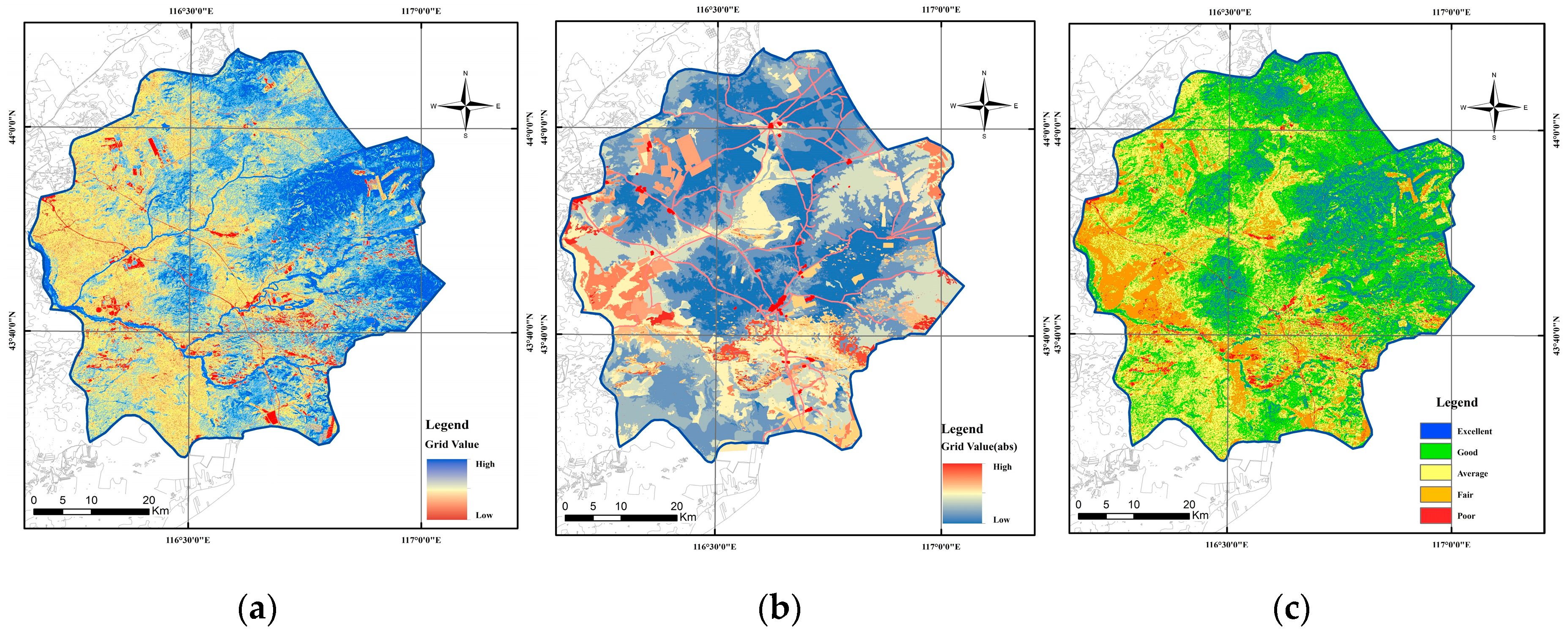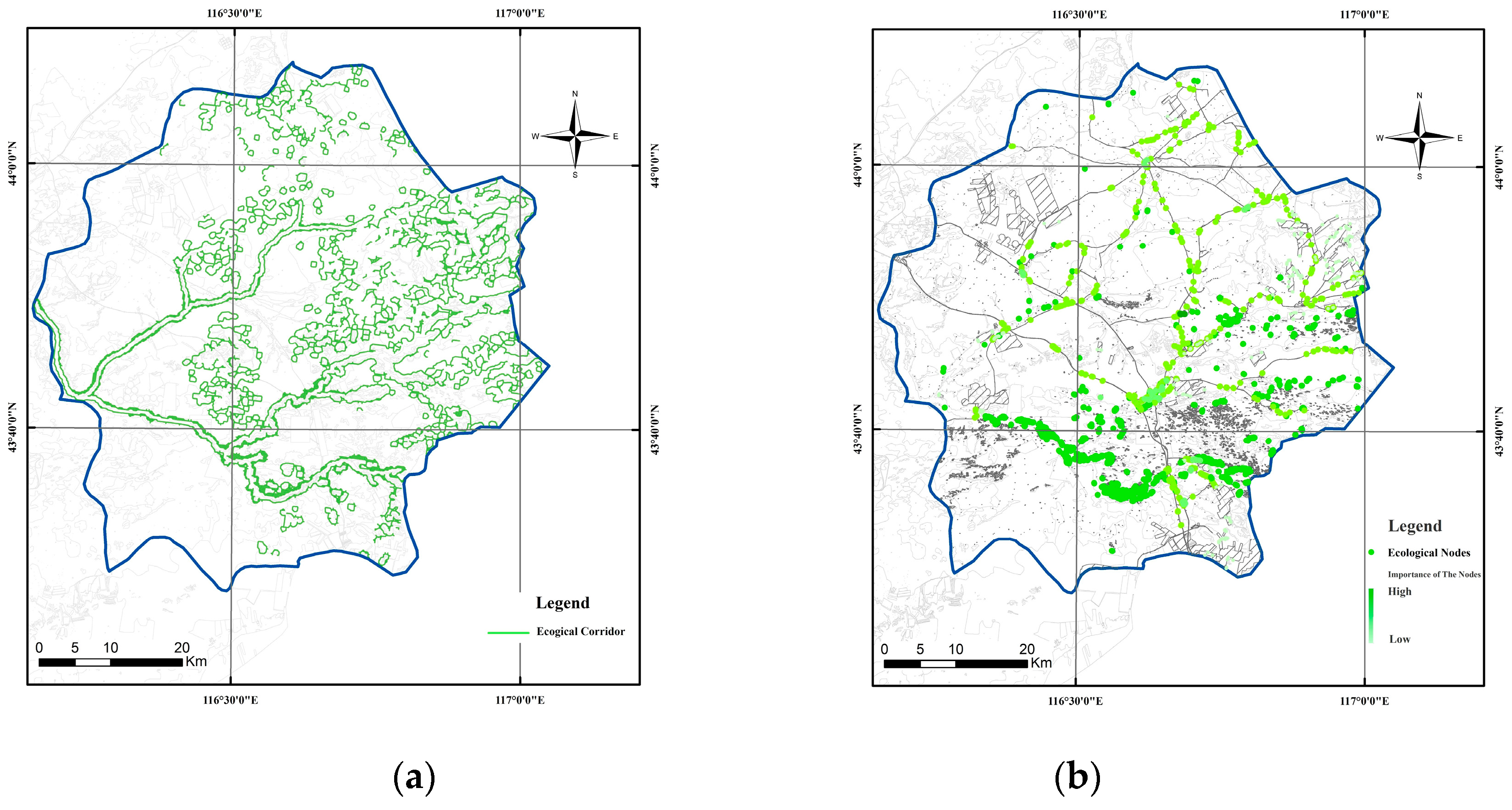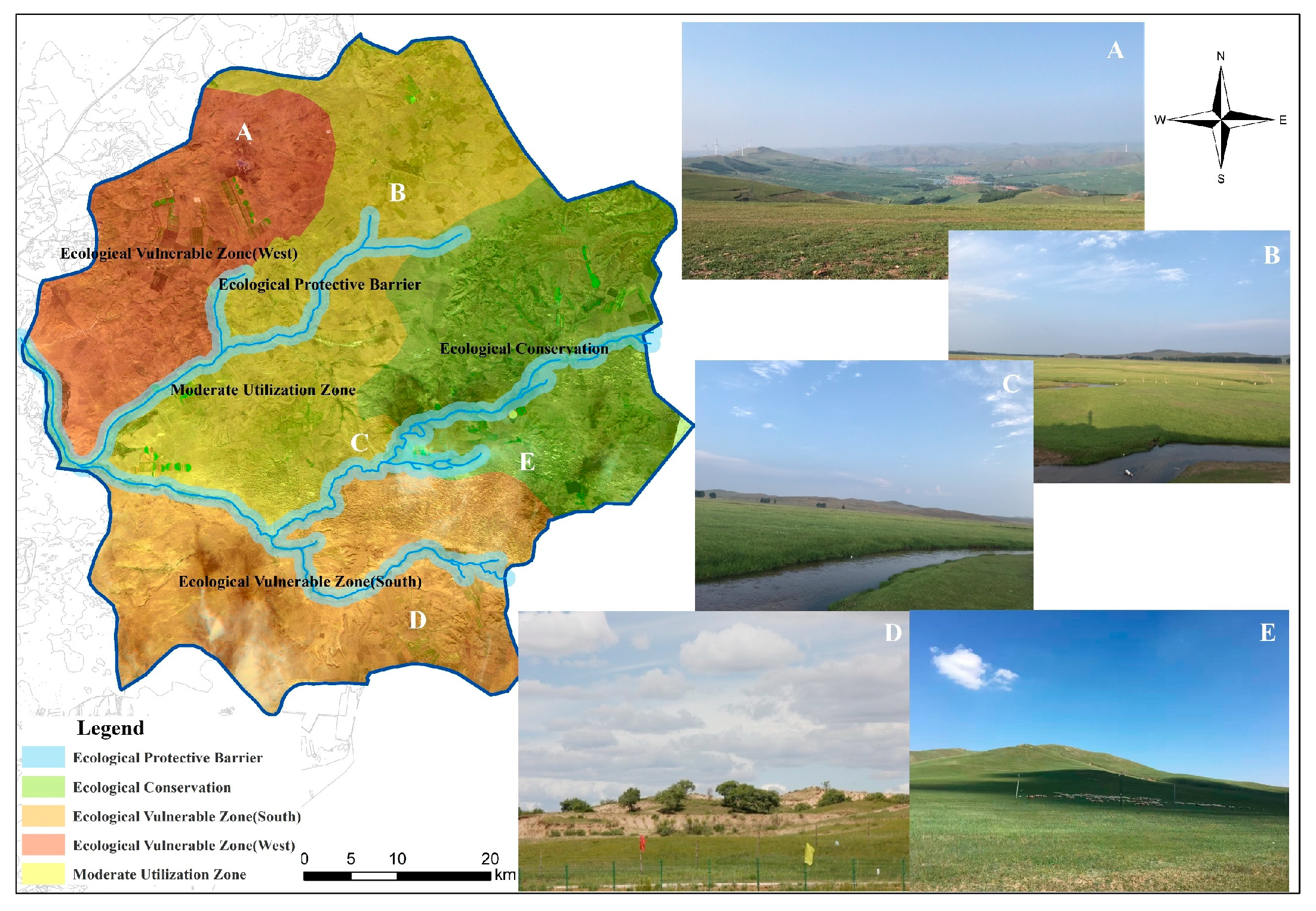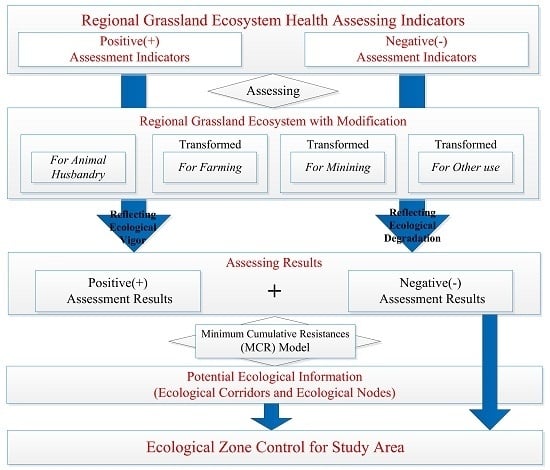An Assessment Framework for Grassland Ecosystem Health with Consideration of Natural Succession: A Case Study in Bayinxile, China
Abstract
:1. Introduction
2. Materials and Methods
2.1. Study Area
2.2. Building Assessment Framework
2.3. Data Acquisition and Processing
2.3.1. Present Situation of Land Use
2.3.2. Net Primary Productivity (NPP)
2.3.3. Temperature-Vegetation Dryness Index (TVDI)
2.3.4. Revised Universal Soil Loss Equation (RUSLE)
2.3.5. Minimum Cumulative Resistance (MCR) Model
2.3.6. Comprehensive Assessment
3. Results
3.1. Indicator Weight
3.2. Result of Assessing Indicators
3.3. Results of Grassland Health Assessment
3.4. Potential Ecological Information
3.5. Ecological Control Zones
4. Discussion
5. Conclusions
Author Contributions
Funding
Acknowledgments
Conflicts of Interest
References
- Behmanesh, B.; Barani, H.; Sarvestani, A.A.; Shahraki, M.R.; Sharafatmandrad, M. Rangeland degradation assessment: A new strategy based on the ecological knowledge of indigenous pastoralists. Solid Earth 2016, 7, 611–619. [Google Scholar] [CrossRef]
- Ojima, D.S.; Chuluun, T.; Galvin, K.A. Social–Ecological Vulnerability of Grassland Ecosystems. In Climate Vulnerability, 1st ed.; Pielke, R.A., Ed.; Academic Press: Salt Lake City, UT, USA, 2013; pp. 151–162. ISBN 978-0-12-384704-1. [Google Scholar]
- Guo, Z.G.; Liang, T.G.; Liu, X.Y.; Niu, F.J. A new approach to grassland management for the arid Aletai region in Northern China. Rangel. J. 2006, 28, 97–104. [Google Scholar] [CrossRef]
- Wang, X.G.; Han, J.G.; Dong, Y.P. Recent grassland policies in China—An overview. Outlook Agric. 2005, 34, 105–110. [Google Scholar] [CrossRef]
- Ma, L. Basin Thoughts and Policy Suggestions of Delimiting Grassland Ecological Protection Red Line. Acta Agrestia Sin. 2014, 22, 229–233. (In Chinese) [Google Scholar] [CrossRef]
- Yang, X.D.; Yang, C.; Meng, Z.X. The current situation, problem and suggestions of grassland ecological protection in China. Pratac. Sci. 2016, 33, 1901–1909. (In Chinese) [Google Scholar]
- Zhou, W.; Yang, H.; Huang, L.; Chen, C.; Lin, X.S.; Hu, Z.J.; Li, J.L. Grassland degradation remote sensing monitoring and driving factors quantitative assessment in China from 1982 to 2010. Ecol. Indic. 2017, 83, 303–313. [Google Scholar] [CrossRef]
- Rapport, D.J. The ecology of health. Ecology 2012, 93, 1241–1242. [Google Scholar] [CrossRef]
- Kruse, M. Ecosystem Health Indicators. In Encyclopedia of Ecology, 2nd ed.; Fath, B., Ed.; Elsevier: Amsterdam, The Netherlands, 2019; Volume 1, pp. 407–414. ISBN 978-0-444-64130-4. [Google Scholar]
- Rapport, D.J.; Maffi, L. Eco-cultural health, global health, and sustainability. Ecol. Res. 2011, 26, 1039–1049. [Google Scholar] [CrossRef]
- Costanza, R. Ecosystem health and ecological engineering. Ecol. Eng. 2012, 45, 24–29. [Google Scholar] [CrossRef]
- Maron, M.; Mitchell, M.G.E.; Runting, R.K.; Rhodes, J.R.; Mace, G.M.; Keith, D.A.; Watson, J.E.M. Towards a Threat Assessment Framework for Ecosystem Services. Trends Ecol. Evol. 2017, 32, 240–248. [Google Scholar] [CrossRef] [Green Version]
- Drobnik, T.; Greiner, L.; Keller, A.; Grêt-Regamey, A. Soil quality indicators–From soil functions to ecosystem services. Ecol. Indic. 2018, 94, 151–169. [Google Scholar] [CrossRef]
- Raufirad, V.; Hunter, R.; Endress, B.A.; Bagheri, S. Application of Vulnerability Assessment to a Grazed Rangeland: Toward an Integrated Conceptual Framework. Rangelands 2018, 40, 17–23. [Google Scholar] [CrossRef]
- Sheley, R.L.; James, J.J.; Vasquez, E.A.; Svejcar, T.J. Using Rangeland Health Assessment to Inform Successional Management. Invasive Plant Sci. Manag. 2011, 4, 356–366. [Google Scholar] [CrossRef]
- Li, Y.Y.; Dong, S.K.; Wen, L.; Wang, X.X.; Wu, Y. Three-dimensional framework of vigor, organization, and resilience (vor) for assessing rangeland health: A case study from the alpine meadow of the Qinghai-Tibetan plateau, China. EcoHealth 2013, 10, 423–433. [Google Scholar] [CrossRef] [PubMed]
- Yan, Y.; Zhao, C.L.; Wang, C.X.; Shan, P.; Zhang, Y.J.; Wu, G. Ecosystem health assessment of the Liao River Basin upstream region based on ecosystem services. Acta Ecol. Sin. 2016, 36, 294–300. [Google Scholar] [CrossRef]
- Qin, Z.H.; Xu, B.; Xin, X.P.; Zhou, Q.B.; Zhang, H.O.; Liu, J. Integration of remote sensing and GIS technology to evaluate grassland ecosystem health in north China. In Proceedings of the IEEE 2004 International Geosciences and Remote Sensing Symposium, Anchorage, AK, USA, 20–24 September 2004; pp. 4034–4037. [Google Scholar] [CrossRef]
- Hof, J.; Flather, C.H. Optimization of landscape pattern. In Key Topics in Landscape Ecology, 1st ed.; Wu, J.G., Hobbs, R., Eds.; Cambridge University Press: Cambridge, UK, 2007; Volume 8, pp. 143–160. [Google Scholar]
- Liang, J.; He, X.Y.; Zeng, G.M.; Zhong, M.Z.; Gao, X.; Li, X.; Li, X.D.; Wu, H.P.; Feng, C.T.; Xing, W.L.; et al. Integrating priority areas and ecological corridors into national network for conservation planning in China. Sci. Total Environ. 2018, 626, 22–29. [Google Scholar] [CrossRef] [PubMed]
- Rapport, D.J. Gaining respectability: Development of quantitative methods in ecosystem health. Ecosyst. Health 1999, 5, 1–2. [Google Scholar] [CrossRef]
- Chen, T.; Bao, A.M.; Jiapaer, G.L.; Guo, H.; Zheng, G.X.; Jiang, L.L.; Chang, C.; Tuerhanjiang, L. Disentangling the relative impacts of climate change and human activities on arid and semiarid grasslands in Central Asia during 1982–2015. Sci. Total Environ. 2019, 653, 1311–1325. [Google Scholar] [CrossRef]
- Costanza, R.; Arge, R.; Groot, R.; Farber, S.; Grasso, M.; Hannon, B.; Limburg, K.; Naeem, S.; O’Neill, R.V.; Paruelo, J.; et al. The value of the world’s ecosystem services and natural capital. Nature 1997, 387, 253–260. [Google Scholar] [CrossRef]
- Ministry of Agriculture and Rural Affairs of The People’s Republic of China. Available online: http://www.moa.gov.cn/xw/zwdt/201808/t20180803_6155252.htm (accessed on 5 August 2018).
- Lal, R. Soil conservation and ecosystem services. Int. Soil Water Conserv. Res. 2014, 2, 36–47. [Google Scholar] [CrossRef] [Green Version]
- Brown, T.C.; John, C.B.; John, B.L. Defining, valuing and providing ecosystem goods and services. Nat. Resour. J. 2007, 47, 329–376. [Google Scholar] [CrossRef]
- Klimeš, F.; Kolář, L.; Květ, J.; Boberfeld, W.O.V.; Laser, H. Methodological aspects in the study of species richness, diversity and homotony of grass cover. Plant Soil Environ. 2007, 53, 33–41. [Google Scholar] [CrossRef]
- Chang, X.L.; Lv, S.H.; Feng, Z.Y.; Ye, S.X. Impact of topography on the spatial distribution pattern of net primary productivity in a meadow. Acta Ecol. Sin. 2015, 35, 3339–3348. (In Chinese) [Google Scholar] [CrossRef]
- Jenks Natural Breaks Classification. Available online: http://wiki.gis.com/wiki/index.php/Jenks_Natural_Breaks_Classification (accessed on 5 August 2018).
- Sandholt, I.; Rasmussen, K.; Andersen, J. A simple interpretation of the surface temperature/vegetation index space for assessment of surface moisture status. Remote Sens. Environ. 2002, 79, 213–224. [Google Scholar] [CrossRef]
- Erosion Mechanisms and the Revised Universal Soil Loss Equation (RUSLE). Available online: http://rpitt.eng.ua.edu/Class/Erosioncontrol/Module3/Module3.htm (accessed on 20 September 2018).
- Revised Universal Soil Loss Equation (RUSLE)—Welcome to RUSLE 1 and RUSLE 2. Available online: https://www.ars.usda.gov/southeast-area/oxford-ms/national-sedimentation-laboratory/watershed-physical-processes-research (accessed on 20 September 2018).
- Wischmeier, W.H. A rainfall erosion index for a universal soil loss equation. Soil Sci. Soc. Am. J. 1959, 23, 246–249. [Google Scholar] [CrossRef]
- Shirazi, M.A.; Hart, J.W.; Boersma, L. A Unifying Quantitative Analysis of Soil Texture: Improvement of Precision and Extension of Scale. Soil Sci. Soc. Am. J. 1988, 52, 181–190. [Google Scholar] [CrossRef]
- McCool, D.K.; Brown, L.C.; Foster, G.R.; Mutchler, C.K.; Meyer, L.D. Revised slope steepness factor for the universal soil loss equation. Trans. ASAE 1987, 30, 1387–1396. [Google Scholar] [CrossRef]
- Liu, B.Y.; Nearing, M.A.; Risse, L.M. Slope gradient effects on soil loss for steep slopes. Trans. ASAE 1994, 37, 1835–1840. [Google Scholar] [CrossRef]
- Xu, Q.X.; Wang, T.W.; Li, Z.X.; Cai, C.F.; Shi, Z.H. Effect of soil conservation measurements on runoff, erosion and plant production: A case study on steep lands from the Three Gorges Area, China. J. Food Agric. Environ. 2010, 8, 980–984. [Google Scholar] [CrossRef]
- Chen, S.X.; Yang, X.H.; Xiao, L.L.; Cai, H.Y. Study of Soil Erosion in the Southern Hillside Area of China Based on RUSLE Model. Resour. Sci. 2014, 36, 1288–1297. (In Chinese) [Google Scholar]
- Wu, J.G. Cross-disciplinarily, landscape ecology, and sustainability science. Landsc. Ecol. 2006, 21, 1–4. [Google Scholar] [CrossRef]
- Wang, Y.F.; Zhang, J.Q.; Guo, E.L.; Sun, Z.Y. Fuzzy Comprehensive Evaluation-Based Disaster Risk Assessment of Desertification in Horqin Sand Land, China. Int. J. Environ. Res. Public Health 2015, 12, 1703–1725. [Google Scholar] [CrossRef] [PubMed] [Green Version]
- Wu, H.W.; Li, J.; Li, X.Y.; He, B.; Liu, J.Z.; Jiang, Z.Y.; Zhang, C.C. Contrasting response of coexisting plant’s water-use patterns to experimental precipitation manipulation in an alpine grassland community of Qinghai Lake watershed, China. PLoS ONE 2018, 13, e0194242. [Google Scholar] [CrossRef] [PubMed]
- Ives, A.R.; Carpenter, S.R. Stability and Diversity of Ecosystems. Science 2007, 317, 58–62. [Google Scholar] [CrossRef] [PubMed]
- Robinson, B.E.; Li, P.; Hou, X.Y. Institutional change in social-ecological systems: The evolution of grassland management in Inner Mongolia. Glob. Environ. Chang. 2017, 47, 64–75. [Google Scholar] [CrossRef]






| 1st-Level Indicator | 2nd-Level Indicator | 3rd-Level Indicator | Direction and Method | Grade | Score |
|---|---|---|---|---|---|
| Positive assessing indicator | Ecological function | Plant diversity | The species richness index was used to calculate the plant diversity of grassland [27]. Sample points were arranged according to the habitat conditions (human activity intensity being the major consideration) of the study area. Each sample point was set with 3 samples (in which grass community was 1 m × 1 m and shrub was 10 m × 10 m) to record the species richness. | Highest | 5 |
| High | 4 | ||||
| Medium | 3 | ||||
| Low | 2 | ||||
| Lowest | 1 | ||||
| Productive function | Food supplement | Output of farmland was considered to be the highest. Food productivity of grazing land was reflected by vegetation biomass. | High | 5 | |
| Medium | 3 | ||||
| Low | 1 | ||||
| Environmental function | Climate regulation | Net Primary Productivity (NPP) was used to indirectly reflect climate regulation capacity of vegetation according to the positive correlation between vegetation biomass and its carbon cycle and climate regulation capacity [25,26]. | Highest | 5 | |
| High | 4 | ||||
| Medium | 3 | ||||
| Low | 2 | ||||
| Lowest | 1 | ||||
| Water and soil conversation capacity | NPP was used to reflect the water and soil conversation capacity. We assigned a value of 5 to the area with a figure above 200 g/m2 and a value of 1 to the area with a figure below 50 g/m2, and assigned null to the area with no vegetation. | High | 5 | ||
| Medium | 3 | ||||
| Low | 1 | ||||
| Water distribution | The TVDI Index was used to reflect the water distribution of the surface soil. | Highest | 5 | ||
| High | 4 | ||||
| Medium | 3 | ||||
| Low | 2 | ||||
| Lowest | 1 | ||||
| Cultural service function | Entertainment Service value | The distribution density of tourist spots was used to reflect the entertainment service value. | Highest | 5 | |
| High | 4 | ||||
| Medium | 3 | ||||
| Low | 2 | ||||
| Lowest | 1 | ||||
| Topographical condition | Aspects | The distribution characteristics of NPP was used on aspects and slope to assign the value for each aspect and slope. Among them, the classification of aspects and slope used was set out in <General rule of planning for comprehensive control of soil erosion> of China (GB/T 15772–2008) and a previous study made by Chang et al. [28] | N | 5 | |
| W | 4 | ||||
| E | 3 | ||||
| Flat | 2 | ||||
| S | 1 | ||||
| Slope | 15°~25° | 5 | |||
| 8°~15° | 4 | ||||
| 5°~8° | 3 | ||||
| <5° | 2 | ||||
| >25° | 1 | ||||
| Negative assessing indicator | Human activity | Human activity intensity | The result of point density analysis for residential buildings was used to reflect the human activity intensity. | Highest | −5 |
| High | −4 | ||||
| Medium | −3 | ||||
| Low | −2 | ||||
| Lowest | −1 | ||||
| Grassland transformation | It was evaluated according to the restoration difficulty of transformed land types. The result showed: Mining land>Road, Construction land>Farmland, Country Road | Heavily | −5 | ||
| Moderately | −3 | ||||
| Slightly | -1 | ||||
| Natural disaster | Soil erosion | The RUSLE model was used to calculate the soil erosion of study area. | Extremely | −5 | |
| Strongly | −4 | ||||
| Moderately | −3 | ||||
| Slightly | −1 | ||||
| Grassland retrogressive succession | Desertification | The grassland resources investigation data of Inner Mongolia in 2010 and 2016, which include information about the degradation, desertification and salinization of Inner Mongolian grassland. | Heavily | −5 | |
| Moderately | −3 | ||||
| Slightly | −1 | ||||
| Salinization | Heavily | −5 | |||
| Moderately | −3 | ||||
| Slightly | −1 | ||||
| Degradation | Heavily | −5 | |||
| Moderately | −3 | ||||
| Slightly | −1 |
| Data Name | Date | Sources |
|---|---|---|
| Grassland resources investigation data of Inner Mongolia | 2010, 2016 | Grassland Investigation and Planning Institute of Inner Mongolia |
| Soil database of Bayinxile | 2010 | Grassland Investigation and Planning Institute of Inner Mongolia |
| Land use data of Bayinxile | 2010 | Grassland Investigation and Planning Institute of Inner Mongolia |
| GF–2 (1 m × 1 m) | July 2016 | Grassland Investigation and Planning Institute of Inner Mongolia |
| Landsat-8oli/TIRS | July 2016, Sep. 2016 | USGS (http://glovis.usgs.gov) |
| ASTER GDEM v2 (30 m) | - | Computer Network Information Centre, CAS (http://www.gscloud.cn) |
| Rainfall data | 2010–2016 | National Meteorological Science Data Sharing Service Platform, China (http://data.cma.cn/) |
| Statistical yearbook data | 2010–2016 | - |
| Field monitoring data | 2016 | - |
| Grade | Ecological Status | |
|---|---|---|
| 1 | Excellent | An area with dynamic and stable ecological structure |
| 2 | Good | An area with better vigor and less external interference |
| 3 | Average | An area with moderate external interference and obvious degradation trend |
| 4 | Fair | An area with excessive human activities and degraded grassland |
| 5 | Poor | An area transformed from native grassland |
| Criterion | Subcriterion | Weight |
|---|---|---|
| Ecological function | Plant diversity | 0.062 |
| Productive function | Food supplement | 0.1418 |
| Environmental function | Climate regulation | 0.2171 |
| Water and soil conversation capacity | 0.0873 | |
| Water distribution | 0.0266 | |
| Entertainment function | Entertainment Service value | 0.017 |
| Topographical condition | Aspects | 0.0213 |
| Slope | 0.0183 | |
| Human activity | Human activity intensity | 0.0989 |
| Grassland transformation | 0.1312 | |
| Natural disaster | Soil erosion | 0.0557 |
| Grassland retrogressive succession | Desertification | 0.0366 |
| Salinization | 0.0345 | |
| Degradation | 0.0515 |
© 2019 by the authors. Licensee MDPI, Basel, Switzerland. This article is an open access article distributed under the terms and conditions of the Creative Commons Attribution (CC BY) license (http://creativecommons.org/licenses/by/4.0/).
Share and Cite
Wu, N.; Liu, A.; Wang, Y.; Li, L.; Chao, L.; Liu, G. An Assessment Framework for Grassland Ecosystem Health with Consideration of Natural Succession: A Case Study in Bayinxile, China. Sustainability 2019, 11, 1096. https://doi.org/10.3390/su11041096
Wu N, Liu A, Wang Y, Li L, Chao L, Liu G. An Assessment Framework for Grassland Ecosystem Health with Consideration of Natural Succession: A Case Study in Bayinxile, China. Sustainability. 2019; 11(4):1096. https://doi.org/10.3390/su11041096
Chicago/Turabian StyleWu, Nitu, Aijun Liu, Yongfang Wang, Lanhua Li, Lumengqiqige Chao, and Guixiang Liu. 2019. "An Assessment Framework for Grassland Ecosystem Health with Consideration of Natural Succession: A Case Study in Bayinxile, China" Sustainability 11, no. 4: 1096. https://doi.org/10.3390/su11041096
APA StyleWu, N., Liu, A., Wang, Y., Li, L., Chao, L., & Liu, G. (2019). An Assessment Framework for Grassland Ecosystem Health with Consideration of Natural Succession: A Case Study in Bayinxile, China. Sustainability, 11(4), 1096. https://doi.org/10.3390/su11041096





